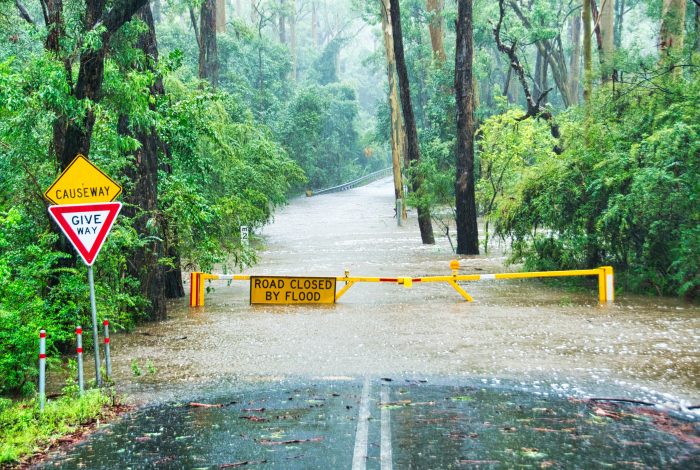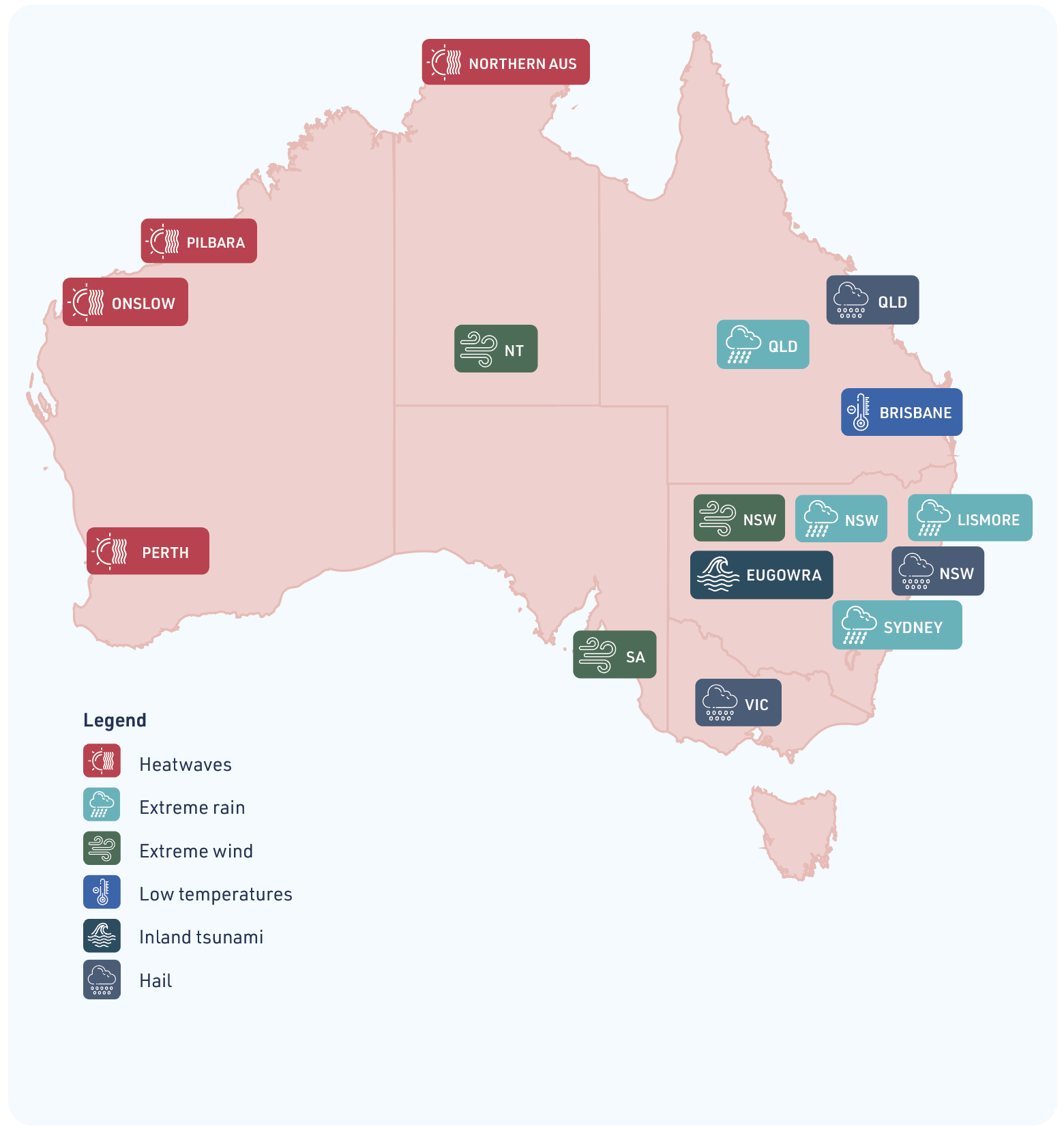About this report
Climate extremes already affect many facets of Australian society including health, soil and water, agriculture, infrastructure, energy security and financial security, posing significant risks to the global and Australian economy.
Our region will face more and more intense extremes in the future, even with rapid and deep cuts in greenhouse gas emissions.
This report provides a summary of the significant extreme weather and climate events which occurred in 2022 across Australia and Antarctica. The report provides a description of each event and an explanation which reflects our understanding of the causes. Our research continues to learn more about these events.
This report has been prepared to assist policy makers and the general public understand the complexity and nature of the climate extremes we are experiencing.

2022 in summary
A third consecutive La Niña contributed to severe rainfall and flooding across Eastern Australia.
Australia’s hottest temperature was recorded in the coastal town of Onslow, Western Australia.
Weather and climate extremes had disastrous impacts on socioeconomic systems.

Australia experienced a year of record-breaking extreme events in 2022 with extreme rain and flooding overshadowing all other events. Second and third consecutive La Niña events dominated the weather and climate across eastern Australia. The three successive phases in La Niña contributed to persistent, heavy rainfall breaking multiple daily, monthly and yearly flood and rainfall records.
While La Niña promoted cooler and damper conditions in the east of the country, Australia still equalled its highest temperature ever in Western Australia. Regionally records also fell for extreme heat in the Antarctic which had a significant year of ice melt.

Rainfall
Much of Australia experienced above average rainfall for 2022, as the second La Niña transitioned to a third consecutive La Niña accompanied by wet phase climate drivers: a negative Indian Ocean Dipole (IOD) and a predominantly positive Southern Annular Mode (SAM).
Temperature
As the rainfall records were surpassed in 2022, so too were the extreme heat records. The average temperature over Australia has warmed by 1.47± 0.24°C since 1910.
Large scale climate drivers
A lingering La Niña influenced Australian rainfall for much of 2022. La Niña is an ocean temperature and wind pattern across the Pacific Ocean which pushes warm and moist air towards Australia. It therefore has an important influence on Australian rainfall, promoting increased winter-spring rainfall in eastern Australia and increased late summer-autumn rainfall along the east coast.
Weather and climate extremes in Antarctica
The Antarctic saw a series of extreme events over 2022: simultaneous heatwaves in Antarctic and Arctic, a major collapse of the Conger ice shelf in East Antarctica and record low Antarctic sea ice observations.
Social impacts of climate extremes
The extremes throughout 2022 were disastrous for local communities. At least 23 people died from the flooding in south-eastern Queensland and eastern New South Wales in early 2022. The State Emergency Service considered over 3,600 homes across the New South Wales northern rivers region as uninhabitable. The New South Wales State Emergency Service responded to 31,400 calls for help in the six-week period.
International extreme events
Looking beyond Australia, a range of extreme events took place globally with 2022 the sixth warmest year on record.
It was the warmest La Niña year on record globally.
Record high levels of carbon dioxide in 2022
In May 2022, atmospheric carbon dioxide hit the highest level in over 4 million years, reaching 421 parts per million.

Extreme weather and climate events in 2022

Heatwaves in Western Australia
- Western Australia experienced a series of heatwaves in December 2021 – January 2022.
- The coastal town of Onslow, Western Australia, equalled Australia’s hottest day at 50.7°C.

Extreme rainfall and flooding in Queensland and New South Wales February-March 2022
- Rainfall was 5 times the February monthly average for some areas of south-eastern Queensland and eastern New South Wales.
- Over 500 millimetres of rain fell during a two-week period in March 2022.
- The flooding caused loss of life and an estimated AU$3.35 billion in insured losses.

Record low Antarctic sea ice extent in 2022
- Record low values of sea ice extent in Antarctic in 2022.
- Implications for local marine life, the food chain and ice sheet melt.

Simultaneous Antarctic and Arctic heatwaves
- Two record-breaking heatwaves occurred simultaneously in the Antarctic and Arctic.
- Temperatures reached about 40°C above normal.

Collapse of East Antarctic Conger ice shelf
- The 1200 square km Conger ice shelf collapsed in March 2022.
- The collapse of an ice shelf is a rare event.

Coldsnap in Queensland
- Many regions in Queensland recorded the lowest ever maximum temperature for July.
- Toowoomba in southern Queensland had its coldest July day on record reaching 7.6°C on the 4th.

Sydney’s wettest year on record
- Sydney experienced its wettest year on record in 2022.
- Three weather events were responsible for 40% of the total rainfall in 2022.

An “inland tsunami” hits Eugowra
- River levels peaked at a record breaking 11.2 metres after 120mm of rain on 13 November 2022.
- On November 14th 2022, Eugowra in New South Wales was hit by a devastating one-in-5000-year flash flooding event.

Hailstorms in Queensland, Victoria and New South Wales
- Victoria, Queensland, and New South Wales all experienced damaging hail events in the 2022 storm seasons.
- Reported damage included potato, citrus, and grape crops with some growers losing 30-50% of their crops.

Northern Australia heatwave
- Northern Australia experienced extreme temperatures during December, with mid to high 40s in many locations.
- The extreme temperatures are unusual for tropical regions.

Damaging wind gusts in South Australia and the Northern Territory
- Severe winds impacted parts of South Australia and the Northern Territory On the 12th of November 2022.
- Damage included failure of transmission lines in South Australia and damage to buildings, including the removal of a roof off of a school in the Northern Territory.

Download this report
This report is also available as a PDF.
To contact us about the report, email clex@unsw.edu.au
The State of Weather and Climate Extremes 2022
Weather and climate extremes in Antarctica
Extreme events in 2022
Heatwaves in Western Australia
Extreme rainfall and flooding in Queensland and New South Wales February-March 2022
Record low Antarctic sea ice extent in 2022
Simultaneous Antarctic and Arctic heatwaves
Collapse of East Antarctic Conger ice shelf
Hailstorms in Queensland, Victoria and New South Wales
Damaging wind gusts in South Australia and the Northern Territory
© 2023 ARC Centre of Excellence for Climate Extremes
References and acknowledgements available in the PDF version available here.
Materials used are for educational purposes and either author provided or used under fair dealing provisions.
